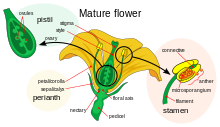Style (botany)

In botany, the style of an angiosperm flower is an organ of variable length that connects the ovary to the stigma. The style does not contain ovules; these are limited to the region of the gynoecium (female organs of the flower) called the "ovary."
Structure[edit]
The style is a narrow extension of the ovary, usually pointing upwards, connecting the ovary to the stigmatic papillae. It may be absent in some plants; in this case, it is referred to as a sessile stigma. Styles generally resemble more or less long tubes. The style can be open (with few cells occupying the central part, or even none), featuring a central canal that may be filled with mucilage. Alternatively, the style can be closed (completely filled with cells). Most plants with syncarpous pistils (monocotyledons and some eudicotys) have open styles, whereas many eudicots and grasses have closed (solid) styles containing specialized secretory tissues, which connect the stigma to the center of the ovary. These tissues form a nutrient-rich cord for the growth of the pollen tube.[1]
When the pistil consists of several carpels, each of them may have a distinct stylodium (pseudo-style[verification needed]) or share a common style. In Iris and other species of the Iridaceae family, the style divides into three "petaloid branches" (resembling petals), sometimes also called stylodiums,[1] almost at the origin of the style and is called "tribrachiate". These are strips of tissue emerging from the perianth tube above the sepal. The stigma is a ridge or edge on the lower surface of the branch, near the tip of the lobes.[2] Branched styles also appear in the genera Dietes, Pardanthopsis, and in most species of the genus Moraea.[3]
In Crocus species, the style is branched into three "branches," forming a tube.[4] Plants of the genus Hesperantha have a spread-out branched style. The style can also be lobed rather than branched. Plants of the genus Gladiolus have a bilobed style. In the genera Freesia, Lapeirousia, Romulea, Savannosiphon, and Watsonia, the style has bifurcated and curved branches.[5][6]
Attachment to the ovary[edit]
May be terminal (apical), subapical, lateral, gynobasic, or subgynobasic. Terminal (apical) style position refers to attachment at the apex of the ovary and is the most common pattern. In the subapical pattern, the style arises to the side slightly below the apex. A lateral style arises from the side of the ovary and is found in Rosaceae. The gynobasic style arises from the base of the ovary, or between the ovary lobes and is characteristic of Boraginaceae. Subgynobasic styles characterise Allium.[7]
Pollination[edit]
Pollen tubes grow the length of the style to reach the ovules, and in some cases self-incompatibility reactions in the style prevent full growth of the pollen tubes. In some species, including Gasteria at least, the pollen tube is directed to the micropyle of the ovule by the style.[8]
References[edit]
- ^ a b Rudall 2007.
- ^ "The Anatomy of Irises". herbs2000.com. Retrieved 27 July 2015..
- ^ Huber, H.; Rudall, P.J.; Stevens, P.S.; Stützel, T. (2013). Kubitzki, Klaus (ed.). Flowering Plants. Dicotyledons : Celastrales, Oxalidales, Rosales, Cornales and Ericales. The Families and Genera of Vascular Plants. Springer Science & Business Media. p. 305. ISBN 978-3-662-03533-7.
- ^ Hickey, Michael; King, Clive (1988). 100 Families of Flowering Plants. Cambridge University Press. p. 562. ISBN 978-0-521-33700-7.
- ^ Huber, H.; Rudall, P.J.; Stevens, P.S.; Stützel, T. (2013). Kubitzki, Klaus (ed.). Flowering Plants. Dicotyledons : Celastrales, Oxalidales, Rosales, Cornales and Ericales. The Families and Genera of Vascular Plants. Springer Science & Business Media. p. 305. ISBN 978-3-662-03533-7.
- ^ Huber, H.; Rudall, P.J.; Stevens, P.S.; Stützel, T. (2013). Kubitzki, Klaus (ed.). Flowering Plants. Dicotyledons : Celastrales, Oxalidales, Rosales, Cornales and Ericales. The Families and Genera of Vascular Plants. Springer Science & Business Media. p. 305. ISBN 978-3-662-03533-7.
- ^ Simpson 2011, Style position p. 378
- ^ Christophe Clement, Ettore Pacini, Jean-Claude Audran (Editors) Anther and Pollen: From Biology to Biotechnology, p. 151, at Google Books
Sources[edit]
- Rudall, P.J. (2007). Anatomy of Flowering Plants: An Introduction to Structure and Development. Cambridge University Press. ISBN 978-1-139-45948-8. Retrieved 2024-05-06.
- Simpson, Michael G. (2011). Plant Systematics. Academic Press. ISBN 978-0-08-051404-8.






